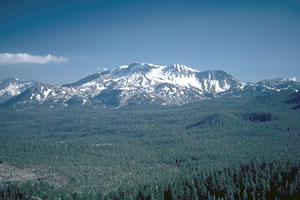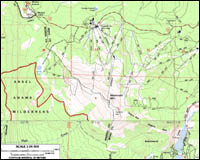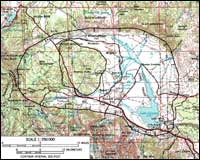 | Mammoth Mountain, still partially snowcovered in late July 1998, seen looking south from the NW rim of Long Valley caldera (photo by S. R. Brantley, USGS) <click to enlarge> |
Mammoth Mountain
(Long Valley Caldera)
11053 ft (3369 m) . |
||
| Location: | Sierra Nevada, Eastern California, 140 miles (225 km) SSE of Reno, NV | ||
| Lat / Long: | 37.6° N, 119.0° W | ||
| Volcanic Type: | Ash-flow caldera and lava dome | ||
| Volcanic Status: | Active (fumarolic) | ||
| First Ascent: | |||
| First Ski Descent: | |||
| Skiable Vertical: | over 3100 ft (1000 m) | ||
| Lift Served Vertical: | over 3100 ft (1000 m) | ||
| Administration: | Inyo National Forest | ||
| Mammoth Mountain is the highest point on the rim of Long Valley Caldera, which is a 10-by-20 mile (15-by-30 km) depression formed following an enormous volcanic eruption about 760,000 years ago. The mountain itself is a large lava dome extruded up along the margin of the caldera. Mammoth Mountain is well known throughout the US, since it has been the site of a major ski area for the past 40 years. The north-facing slopes on which the ski area has strung more than 20 lifts receive an average of over 360 inches of snowfall annually. The high altitude and northerly aspect combine to produce some of the best snow preservation in North America, and Mammoth's ski season often extends from late October through early July. | |||

